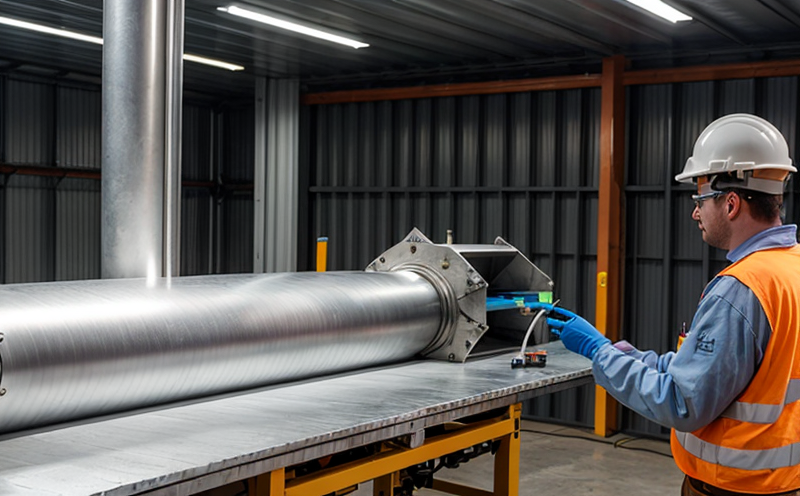ASTM D6110 Charpy Impact Testing of Renewable Plastics
The ASTM D6110 standard specifies a procedure for determining the impact strength (Charpy V-notch) of thermoplastic materials. This method is particularly relevant in the renewable energy sector where the integrity and durability of plastics used in components such as wind turbine blades, solar panel frames, and biofuel containers are crucial.
The Charpy Impact Test involves subjecting a notched sample to controlled impact from a falling pendulum. The test measures how much energy the material can absorb before fracturing. This is critical for renewable applications where materials must withstand extreme environmental conditions, including high winds, UV exposure, and temperature fluctuations.
For renewable plastics, this test ensures that materials meet stringent performance requirements under real-world conditions. The Charpy Impact Test provides a standardized method to assess the toughness of plastic materials used in renewable energy technologies, ensuring they can endure harsh environments without failure.
The ASTM D6110 procedure is widely adopted by quality managers and compliance officers who need to ensure that their products meet international standards. This test helps R&D engineers by providing critical data on material performance under impact conditions. Additionally, procurement teams benefit from this standard as it allows for the selection of materials known to withstand harsh environmental stresses.
The Charpy Impact Test is a key tool in the development and quality assurance processes of renewable energy components. It ensures that plastics used in these applications are robust enough to perform reliably over their intended lifetimes, thereby enhancing the overall safety and efficiency of renewable energy systems.
Understanding the nuances of this test is essential for professionals involved in the manufacturing and testing of renewable energy materials. By adhering to ASTM D6110, manufacturers can ensure that their products meet the highest standards of quality and reliability.
Scope and Methodology
The scope of ASTM D6110 Charpy Impact Testing is broad, encompassing thermoplastic materials used in various applications within renewable energy systems. This includes but is not limited to plastics utilized in the construction of wind turbine blades, solar panel frames, biofuel containers, and other components exposed to extreme environmental conditions.
The methodology involves several key steps:
- Sample Preparation: Specimens are cut from the material under test. They must be free from defects and represent the properties of the bulk material.
- Notch Formation: A V-notch is machined into one end of each specimen, ensuring uniformity in cross-section and notch geometry.
- Testing Procedure: Specimens are mounted on a holder with the notch facing down. The sample is then subjected to impact from a falling pendulum of specified mass and height.
- Data Collection: The energy absorbed by the specimen before fracture is measured using strain gauges or other suitable methods.
The results provide a quantitative measure of material toughness, which is essential for assessing the reliability and durability of materials in renewable applications. This standardized approach ensures consistency across different laboratories and manufacturers, facilitating comparisons and compliance with international standards.
Benefits
Conducting ASTM D6110 Charpy Impact Testing offers numerous benefits:
- Enhanced Material Performance: By ensuring that materials meet the specified impact strength, manufacturers can improve product performance and longevity.
- Compliance with Standards: This test aligns with international standards like ASTM D6110, ensuring compliance and facilitating market entry in regulated sectors.
- Risk Management: Early identification of materials that do not meet the required performance criteria can help avoid costly failures and recalls.
- Innovation Support: This standard provides a robust framework for R&D, enabling continuous improvement and innovation in material science.
- Quality Assurance: Consistent testing across batches ensures that products consistently meet high-quality standards.
- Cost Efficiency: By identifying substandard materials early in the process, companies can minimize waste and optimize resource usage.
- Safety Enhancement: Ensuring material integrity through rigorous testing contributes to safer renewable energy systems.
The results of this test are invaluable for quality managers and compliance officers who need reliable data to make informed decisions. For R&D engineers, the insights gained from these tests can lead to breakthroughs in material science and engineering. Procurement teams benefit by selecting materials that are proven to perform under severe conditions, thus reducing risks and enhancing product reliability.
Quality and Reliability Assurance
The ASTM D6110 Charpy Impact Test is a cornerstone of quality assurance in the renewable energy sector. By rigorously testing materials for their ability to withstand impact, manufacturers can ensure that components used in wind turbines, solar panels, and biofuel containers are reliable and durable.
Quality assurance through this test involves several key steps:
- Sample Selection: Samples must be representative of the material being tested. This ensures that the results accurately reflect the properties of the bulk material.
- Standardized Testing Conditions: All tests are conducted under controlled conditions to ensure consistency and repeatability.
- Data Analysis: Extensive data analysis is performed to interpret the results, providing insights into material performance under impact stress.
- Continuous Improvement: Based on test results, manufacturers can identify areas for improvement and implement changes to enhance product quality.
The reliability of materials tested using ASTM D6110 is critical for the success of renewable energy projects. By adhering to this standard, manufacturers can build trust with their customers and regulatory bodies. This ensures that products meet not only performance criteria but also safety and environmental standards.
Continuous improvement through rigorous testing supports innovation in material science and engineering. As new materials are developed, they undergo Charpy Impact Testing to ensure they meet the required specifications. This commitment to quality and reliability is essential for the success of renewable energy projects and the broader transition to sustainable energy sources.





